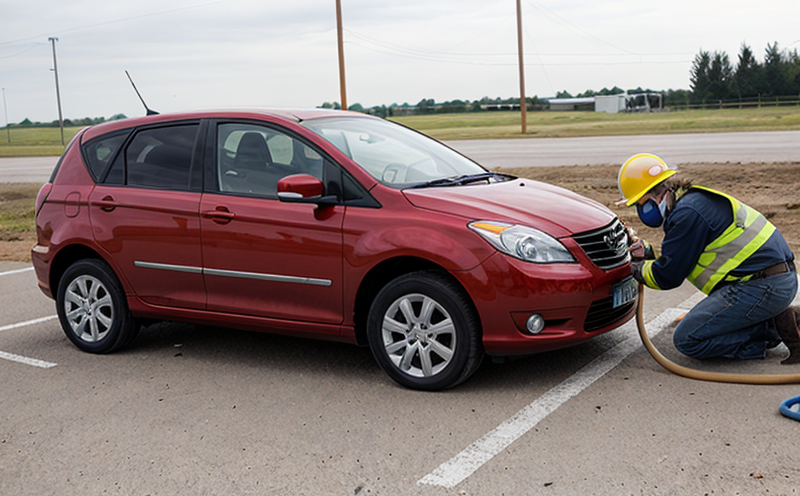EN 50129 Functional Safety Testing for Railway Signalling Equipment
The EN 50129 standard provides a framework for ensuring the functional safety of railway signalling equipment, which is critical in preventing accidents and ensuring passenger and personnel safety. This standard applies specifically to the design, manufacture, commissioning, operation, and maintenance phases of railway signalling systems.
The functional safety testing under EN 50129 encompasses several key aspects that are essential for compliance:
- Identification of potential risks
- Evaluation of risk reduction measures
- Development of a safety concept
- Implementation and validation of the safety concept
- Continuous monitoring and improvement
The testing process is rigorous and involves multiple stages to ensure that all aspects of functional safety are addressed. Key components include:
- Risk Assessment: Identifying hazards, assessing their risk level, and determining the appropriate measures needed to mitigate these risks.
- Safety Integrity Level (SIL) Assignment: Determining the SIL for each part of the system based on its criticality.
- Functional Safety Requirements: Defining requirements that ensure the equipment meets the specified safety integrity levels.
- Testing and Validation: Conducting comprehensive testing to validate that the equipment functions as intended under all conditions, including fault scenarios.
- Continuous Monitoring: Implementing systems for ongoing monitoring and improvement based on real-world performance data.
The testing process is not just about compliance with standards but also involves deep technical expertise. For example, the use of advanced simulation tools and real-time test setups ensures that all potential failure modes are identified before deployment in a live environment.
One critical aspect of EN 50129 is the emphasis on redundancy and fault tolerance. Redundant systems ensure that if one component fails, another can take over seamlessly without compromising safety. This is achieved through careful design and rigorous testing to ensure high reliability and availability.
The standard also requires extensive documentation throughout each phase of development. Detailed records are kept for all tests conducted, including initial assessments, intermediate checks, and final validation. These documents provide a comprehensive history of the equipment's journey from concept to operational readiness, ensuring transparency and accountability.
Compliance with EN 50129 is not just about meeting regulatory requirements; it represents a commitment to excellence in safety engineering. By adhering strictly to this standard, manufacturers can ensure that their products meet the highest levels of functional safety, thereby contributing significantly to public confidence and trust.
Industry Applications
| Application | Description |
|---|---|
| Railway Signalling Systems | This application involves ensuring the safety of signalling equipment used in railway operations, including track circuits and signal boxes. |
| Interlocking Systems | Ensuring that interlocking systems operate correctly to prevent conflicts between trains and maintain safe traffic flow. |
| Safety-Critical Components | The testing of components like relays, switches, and other hardware used in railway signalling systems is crucial for overall system safety. |
| Automatic Train Control (ATC) | Testing the ATC systems to ensure they function correctly under all conditions, including fault scenarios. |
The functional safety testing under EN 50129 is particularly important for railway signalling equipment because of its critical role in ensuring safe and efficient train operations. Any failure in this system can lead to severe consequences, making it imperative that all components meet the highest standards of reliability and safety.
Customer Impact and Satisfaction
- Increased Safety: Compliance with EN 50129 ensures that railway signalling equipment operates safely, reducing the risk of accidents and incidents.
- Regulatory Compliance: Meeting this standard helps customers avoid legal issues and penalties associated with non-compliance.
- Better Reputation: Demonstrating commitment to high safety standards enhances a company's reputation in the industry.
The testing process under EN 50129 is designed not only to meet regulatory requirements but also to exceed them, ensuring that customers receive top-quality products and services. This approach fosters long-term relationships with satisfied customers who trust the reliability of the equipment.
Moreover, by adhering to this standard, manufacturers can ensure that their products are accepted internationally, opening up new markets for export. The rigorous testing process builds confidence in the quality and safety of the products, which is crucial for maintaining customer satisfaction and loyalty.
International Acceptance and Recognition
- Global Standard: EN 50129 has been adopted by many countries worldwide, making it a global standard for functional safety in railway signalling equipment.
- Regulatory Acceptance: Regulatory bodies around the world recognize this standard and require compliance for certain products to be sold or used within their jurisdictions.
The acceptance of EN 50129 is not limited to a single region; it is widely recognized across Europe, Asia, and North America. This global recognition ensures that manufacturers who comply with this standard can sell their products internationally without additional testing or certification.
Compliance with EN 50129 also leads to higher international acceptance of the manufacturer's reputation. This recognition not only enhances market access but also improves customer trust, leading to increased sales and market share.





